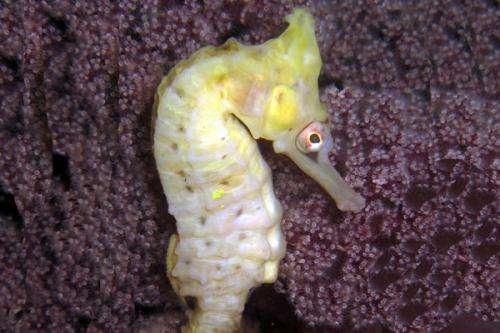Grandma, picture by David Harasti
(Phys.org)—Our understanding of the population dynamics, longevity and reproductive habits of the seahorse species Hippocampus whitei (White's Seahorse) has been significantly expanded thanks to newly published research from UTS doctoral candidate David Harasti.
Listed as "data deficient" under the IUCN Red List of Threatened Species, two separate NSW populations of White's Seahorse revealed their secrets to David via a five-year tagging and recapture program involving close to 1000 individual seahorses, 15 breeding pairs and "Grandma", the oldest known seahorse in the world.
"This really is a 'good news' story. Prior to this research we thought Hippocampus whitei was threatened but we have now established baseline data and discovered important populations in Sydney Harbour and Port Stephens," David said.
"Seahorses and other syngnathids such as pipefishes and sea dragons, are listed as protected species in NSW. However this research confirms for the first time that White's Seahorse has a limited distribution to just nine estuaries from Wollongong to Forster where pressure on estuarine habitats from coastal development keeps increasing," David said.
In another first, this research recorded the remarkably faithful nature of White's Seahorse from breeding season to breeding season.
Footage of capture and tagging of White's Seahorse in sponge gardens at Nelson Bay
"Males and females form bonds and remain faithful to one another and not just for one breeding season. A breeding pair named 'Grandpa' and 'Goldilocks' were found breeding together for three consecutive seasons, remaining faithful to one another the entire time. This is the first time this behaviour has been observed," David said.
And for the pregnant male – the female deposits her eggs in the male's pouch which are fertilised by his sperm – it really can be a labour of love with one male recorded as being pregnant eight times during one breeding season.
The research also compared two population hotspots of White's Seahorse – Sydney Harbour and Port Stephens – and discovered that the more complex habitat of sponge gardens and soft corals in Port Stephens produced larger and faster growing seahorses.
"In Sydney Harbour you find White's Seahorse on artificial structures such as jetties and swimming nets rather than the natural habitats of Port Stephens so it's likely that these masters of disguise have better protection amongst the more complex habitats," David said.
But it was Grandma's age that has given this research one of its most interesting findings.
"The White's seahorse lives longer than initially believed with several males and females recorded living up to five to six years in the wild. At around five and a half years Grandma is the oldest known seahorse living in the wild in the world," David said.
Each seahorse was able to be individually identified by a fluorescent tagging system.
The research is published in the Journal of Fish Biology.
More information: "Population dynamics and life history of a geographically restricted seahorse, Hippocampus whitei", D. Harasti, K. Martin-Smith and W. Gladstone, Journal of Fish Biology 81:4, September 2012.
Provided by University of Technology, Sydney





















